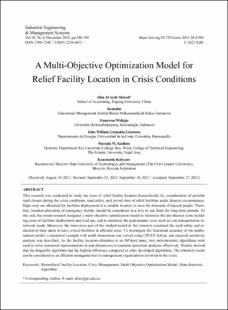Mostrar el registro sencillo del ítem
A multi-objective optimization model for relief facility location in crisis conditions
| dc.contributor.author | Ahmed, Dr. Alim Al Ayub | spa |
| dc.contributor.author | Jaenudin | spa |
| dc.contributor.author | Widjaja, Gunawan | spa |
| dc.contributor.author | Grimaldo Guerrero, John William | spa |
| dc.contributor.author | kadhim, Mustafa Mohammed | spa |
| dc.contributor.author | Kolyazov, Konstantin Alexandrovich | spa |
| dc.date.accessioned | 2022-04-05T12:47:26Z | |
| dc.date.available | 2022-04-05T12:47:26Z | |
| dc.date.issued | 2021 | |
| dc.identifier.issn | 1598-7248 | spa |
| dc.identifier.uri | https://hdl.handle.net/11323/9112 | spa |
| dc.description.abstract | This research was conducted to study the issue of relief facility location hierarchically by consideration of possible road closure during the crisis conditions, road safety, and arrival time of relief facilities under disaster circumstances. High costs are allocated for facilities deployment in a suitable location to meet the demands of injured people. Therefore, location-allocation of emergency facility should be considered in a way to use them for long-term periods. To this end, the extant research designed a multi-objective optimization model to minimize the pre-disaster costs including costs of facilities deployment and road use, and to minimize the post-disaster costs such as cost transportation innetwork roads. Moreover, the innovative part of the studied model in this research examined the road safety and reduction in time taken to have critical facilities in affected areas. To investigate the functional accuracy of the mathematical model, a numerical example with small dimensions was solved using CPLEX Solver, and required sensitivity analysis was described. As the facility location-allocation is an NP-hard issue, two meta-heuristic algorithms were used to solve numerical representations in real dimensions to examine numerical analyses effectively. Results showed that the dragonfly algorithm had the highest efficiency compared to other developed algorithms. The obtained results can be considered as an efficient managerial tool in management organizations involved in the crisis. | eng |
| dc.format.extent | 8 páginas | spa |
| dc.format.mimetype | application/pdf | spa |
| dc.language.iso | eng | |
| dc.rights | Atribución 4.0 Internacional (CC BY 4.0) | spa |
| dc.rights | © 2021 KIIE | spa |
| dc.rights.uri | https://creativecommons.org/licenses/by/4.0/ | spa |
| dc.title | A multi-objective optimization model for relief facility location in crisis conditions | eng |
| dc.type | Artículo de revista | spa |
| dc.identifier.url | https://doi.org/10.7232/iems.2021.20.4.588 | spa |
| dc.rights.accessrights | info:eu-repo/semantics/openAccess | spa |
| dc.identifier.doi | 10.7232/iems.2021.20.4.588 | spa |
| dc.identifier.eissn | 2234-6473 | spa |
| dc.identifier.instname | Corporación Universidad de la Costa | spa |
| dc.identifier.reponame | REDICUC - Repositorio CUC | spa |
| dc.identifier.repourl | https://repositorio.cuc.edu.co/ | spa |
| dc.publisher.place | South Korea | spa |
| dc.relation.ispartofjournal | Industrial Engineering and Management Systems | spa |
| dc.relation.references | Alaswad, S. and Salman, S. (2020), Humanitarian aid and relief distribution (HARD) game, Advances in Engineering Education, 8(2), 22-34. | spa |
| dc.relation.references | Barber, G., Cote, M., Wetmore, F., and Yerkovich, A. (2020), Decision support tool for enhancing supply chain management in disaster relief operations, 2020 Systems and Information Engineering Design Symposium (SIEDS), Charlottesville, VA, USA, 1-6. | spa |
| dc.relation.references | Ghasemi, P., Khalili-Damghani, K., Hafezalkotob, A., and Raissi, S. (2019), Uncertain multi-objective multicommodity multi-period multi-vehicle locationallocation model for earthquake evacuation planning, Applied Mathematics and Computation, 350, 105-132. | spa |
| dc.relation.references | Ghezavati, V., Soltanzadeh, F., and Hafezalkotob, A. (2015), Optimization of reliability for a hierarchical facility location problem under disaster relief situations by a chance-constrained programming and robust optimization, Proceedings of the Institution of Mechanical Engineers, Part O: Journal of Risk and Reliability, 229(6), 542-555. | spa |
| dc.relation.references | Kaveh, M. and Mesgari, M. S. (2019), Improved biogeography-based optimization using migration process adjustment: An approach for location-allocation of ambulances, Computers & Industrial Engineering, 135, 800-813. | spa |
| dc.relation.references | Kovács, G. and Spens, K. M. (2020), Relief supply chain management for disasters: Humanitarian, aid and emergency logistics, Simulation, 436, Available from: https://doi.org/10.4018/978-1-60960-824-8. | spa |
| dc.relation.references | Madani, H., Arshadi Khamseh, A., and TavakkoliMoghaddam, R. (2021), Solving a new bi-objective model for relief logistics in a humanitarian supply chain by bi-objective meta-heuristic algorithms, Scientia Iranica, 28(5), 2948-2971, Available from: https://doi.org/ 10.24200/sci.2020.53823.3438. | spa |
| dc.relation.references | Maharjan, R. and Hanaoka, S. (2020), A credibility-based multi-objective temporary logistics hub locationallocation model for relief supply and distribution under uncertainty, Socio-Economic Planning Sciences, 70, 100727. | spa |
| dc.relation.references | Mauliddina, Y. (2020), The role of supply chain finance in humanitarian aid relief, Master Thesis, Politecnico Di Milano School of Industrial and Information Engineering, p.38. | spa |
| dc.subject.proposal | Hierarchical facility location | eng |
| dc.subject.proposal | Crisis management | eng |
| dc.subject.proposal | Multi-objective optimization model | eng |
| dc.subject.proposal | Meta-heuristic algorithm | eng |
| dc.type.coar | http://purl.org/coar/resource_type/c_6501 | spa |
| dc.type.content | Text | spa |
| dc.type.driver | info:eu-repo/semantics/article | spa |
| dc.type.redcol | http://purl.org/redcol/resource_type/ART | spa |
| dc.type.version | info:eu-repo/semantics/acceptedVersion | spa |
| dc.relation.citationendpage | 595 | spa |
| dc.relation.citationstartpage | 588 | spa |
| dc.relation.citationissue | 4 | spa |
| dc.relation.citationvolume | 20 | spa |
| dc.type.coarversion | http://purl.org/coar/version/c_ab4af688f83e57aa | spa |
| dc.rights.coar | http://purl.org/coar/access_right/c_abf2 | spa |
Ficheros en el ítem
Este ítem aparece en la(s) siguiente(s) colección(ones)
-
Artículos científicos [3154]
Artículos de investigación publicados por miembros de la comunidad universitaria.


